
The amount of federal income tax that the top one percent of taxpayers pay is staggering, but what about the bottom 50 percent? Those individuals only pay about three percent of their income in federal income taxes. As a result, they have negative income tax liability, which means they owe more in refundable tax credits than they actually earn. Those individuals are not disproportionately rich, however. Even though a large portion of the bottom half of taxpayers pays nothing in federal income taxes, they still pay more in payroll and excise taxes than the richest one percent.
In 2017, Maryland and the District of Columbia relied the most on individual income taxes, with each contributing about one-fifth of their own source revenue. The states collecting more than twenty-five percent of their own revenue from individual income taxes were Ohio, Pennsylvania, and Kentucky. While most states start with federal taxable income and adjust gross income, some use their own definition of income. Even those states that use their own definition of income rely heavily on federal rules when calculating their tax base.
State and local income taxes are also an important aspect of the U.S. tax system. Although paying taxes is optional, the federal government still relies on taxpayers to accurately report and calculate their incomes using current tax laws. However, in some cases, taxes are higher than they would otherwise be. For example, a married couple who owns a home with a spouse may opt to pay a lower tax rate. This is true even if they own an investment property or earn a certain amount of money.
The average Federal individual income tax rate was calculated using the income of the 400 richest families in the United States. By using a more comprehensive measure of income, the average rate was 58 percent. These estimates are based on the data collected as of January 1, 2018. Unlike the complete-year data, the preliminary data are best used by comparing them to the estimates from the previous year. For more accurate estimates, consider using full-year data.
Currently, 41 states levy broad-based individual income taxes, and a handful of cities and counties levy a separate income tax. Twenty-one states, however, have a completely different approach to individual income taxes. Those that do not levy a state income tax are outlined in red, while seven states tax only dividends and interest income. As of 2021, Tennessee will phase out its individual income tax.
The federal government collects most of its revenue from individual taxpayers and small businesses. The remaining portion comes from corporate income taxes and other taxes and fees. The federal government earns approximately eight percent of its revenue from individual income taxes, and the amount of federal revenue that individuals pay varies widely. In addition to the federal government, states also receive other forms of revenue. For instance, state governments can collect property taxes from residents and nonresidents. These taxes are the most common source of government revenue, and are one of the most significant sources of federal revenues.

Leave a Reply